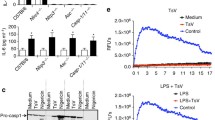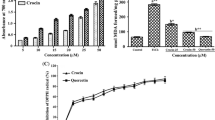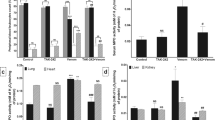Abstract
Androctonus australis hector (Aah) scorpion venom is well known to induce a systemic inflammatory response associated with cell infiltration in lung and edema formation. The present study investigate (i) in vivo the evolution of lung and systemic inflammation triggered by Aah venom and (ii) analyze in vitro the signaling cascade, upstream of inflammatory cytokine expression after Aah venom-stimulated mouse alveolar macrophage (MH-S), the main resident immune cells in the lung. The inflammation induced by Aah venom was assessed in mice through inflammatory cell count, nitric oxide metabolite, and lactate dehydrogenase (LDH) activity in blood, concordantly with neutrophil sequestration in tissue and lung histology. In the in vitro study, MH-S cells are stimulated with Aah venom in the presence of signaling pathway inhibitors, NG25 an inhibitor of transforming growth factor β-activated kinase (TAK1), PD184352 MAP kinase (MKK)1/2 inhibitor, BI605906 an inhibitor of IKκ-β (inhibitor of nuclear factor kappa B), and BIRB0796 an inhibitor of p38 MAPK. Obtained results showed that leukocyte transmigration is important in some area of the lung and is closely associated with systemic increase of nitric oxide and LDH. The in vitro study showed that Aah venom induce significantly an increase of the expression of TNF-α, IL-1β, and MIP-2 in MH-S cells. The pretreatment with inhibitors showed that cytokine increase involves TAK1, IKκ-β, and ERK1/2 pathways, similarly to Toll-like receptor activation. These findings highlight the contribution of alveolar macrophage and their secretory products to tissue damage and made of TAK1 and ERK1/2, an interesting target in scorpion envenomation.






Similar content being viewed by others
References
Adi-Bessalem, S., D. Hammoudi-Triki, and F. Laraba-Djebari. 2008. Pathophysiological effects of Androctonus australis hector scorpion venom: tissue damages and inflammatory response. Experimental and Toxicologic Pathology 60: 373–380.
Raouraoua-Boukari, R., S. Sami-Merah, D. Hammoudi-Triki, M.F. Martin-Eauclaire, and F. Laraba-Djebari. 2012. Immunomodulation of the inflammatory response induced by Androctonus australis hector neurotoxins: biomarker interactions. Neuroimmunomodulation 19: 103–110.
Saidi, H., S. Adi-Bessalem, D. Hammoudi-Triki, and F. Laraba-Djebari. 2013. Effects of atropine and propranolol on lung inflammation in experimental envenomation: comparison of two buthidae venoms. Journal of Venomous Animals and Toxins Including Tropical Diseases 19: 8.
Bekkari, N., M.F. Martin-Eauclaire, and F. Laraba-Djebari. 2015. Complement system and immunological mediators: their involvements in the induced inflammatory process by Androctonus australis hector venom and its toxic components. Experimental and Toxicologic Pathology 67: 389–397.
Fukahara, Y., M. Reis, R. Dellalibera-Joviliani, F. Cunha, and E. Donadi. 2003. Increased levels of IL-1b, IL-6, IL-8, IL-10 and TNF-a in patients moderately or severely envenomed by Tityus serrulatus scorpion sting. Toxicon 41: 49–55.
Meki, A.-R., and Z.M. El-Dean. 1998. Serum interleukin-1β, interleukin-6, nitric oxide and α 1-antitrypsin in scorpion envenomed children. Toxicon 36: 1851–1859.
Hammoudi-Triki, D., E. Ferquel, A. Robbe-Vincent, C. Bon, V. Choumet, and F. Laraba-Djebari. 2004. Epidemiological data, clinical admission gradation and biological quantification by ELISA of scorpion envenomations in Algeria: effect of immunotherapy. Transactions of the Royal Society of Tropical Medicine and Hygiene 98: 240–250.
Taibi-Djennah, Z., and F. Laraba-Djebari. 2015. Effect of cytokine antibodies in the immunomodulation of inflammatory response and metabolic disorders induced by scorpion venom. International Immunopharmacology 27: 122–129.
Zoccal, K.F., C.A. Sorgi, J.I. Hori, F.W. Paula-Silva, E.C. Arantes, C.H. Serezani, D.S. Zamboni, L.H. Faccioli. 2016. Opposing roles of LTB4 and PGE2 in regulating the inflammasome-dependent scorpion venom-induced mortality. Nature Communications. 7.
Christofidou-Solomidou, M., and V.R. Muzykantov. 2006. Antioxidant strategies in respiratory medicine. Treatments in respiratory medicine 5: 47–78.
Kobayashi, H., M. Kobayashi, T.A. Heming, A. Bidani, R.B. Pollard, and F. Suzuki. 1999. Cytokine production by rabbit alveolar macrophages. Differences between activated and suppressor cell phenotypes. Immunology letters 69: 339–346.
Matsunaga, K., T.W. Klein, H. Friedman, and Y. Yamamoto. 2001. Alveolar macrophage cell line MH-S is valuable as an in vitro model for Legionella pneumophila infection. American journal of respiratory cell and molecular biology 24: 326–331.
Wright, J.R. 2004. Host defense functions of pulmonary surfactant. Neonatology 85: 326–332.
Oberdörster, G., J. Ferin, R. Gelein, S.C. Soderholm, and J. Finkelstein. 1992. Role of the alveolar macrophage in lung injury: studies with ultrafine particles. Environmental Health Perspectives 97: 193.
Marshall, B.G., A. Wangoo, H.T. Cook, and R.J. Shaw. 1996. Increased inflammatory cytokines and new collagen formation in cutaneous tuberculosis and sarcoidosis. Thorax 51: 1253–1261.
Ware, L.B. 2006. Pathophysiology of acute lung injury and the acute respiratory distress syndrome. In Seminars in respiratory and critical care medicine. Copyright© by Thieme Medical Publishers, Inc., 333 Seventh Avenue, New York, NY 10001, USA.; 2006: 337–349.
Kaddache, A., M. Hassan, F. Laraba-Djebari, and D. Hammoudi-Triki. 2017. Switch of steady-state to an accelerated granulopoiesis in response to Androctonus australis hector venom. Inflammation 40: 871–883.
Petricevich, V.L., A.H. Cruz, F.I. Coronas, and L.D. Possani. 2007. Toxin gamma from Tityus serrulatus scorpion venom plays an essential role in immunomodulation of macrophages. Toxicon 50: 666–675.
Zoccal, K.F., C. da Silva Bitencourt, F.W.G. Paula-Silva, C.A. Sorgi, Kd.C.F. Bordon, E.C. Arantes, and L.H. Faccioli. 2014. TLR2, TLR4 and CD14 recognize venom-associated molecular patterns from Tityus serrulatus to induce macrophage-derived inflammatory mediators. PLoS One 9: e88174.
Zoccal, K.F., C. da Silva Bitencourt, A. Secatto, C.A. Sorgi, Karla de Castro Figueiredo Bordon, S.V. Sampaio, E.C. Arantes, and L.H. Faccioli. 2011. Tityus serrulatus venom and toxins Ts1, Ts2 and Ts6 induce macrophage activation and production of immune mediators. Toxicon 57: 1101–1108.
Newton, K., and V.M. Dixit. 2012. Signaling in innate immunity and inflammation. Cold Spring Harbor perspectives in biology 4: a006049.
New, D.C., and Y.H. Wong. 2007. Molecular mechanisms mediating the G protein-coupled receptor regulation of cell cycle progression. Journal of molecular signaling 2: 2.
Kang, Y.J., J. Chen, M. Otsuka, J. Mols, S. Ren, Y. Wang, and J. Han. 2008. Macrophage deletion of p38α partially impairs lipopolysaccharide-induced cellular activation. The Journal of Immunology 180: 5075–5082.
Barton, G.M., and R. Medzhitov. 2003. Toll-like receptor signaling pathways. Science 300: 1524–1525.
Senger, K., V.C. Pham, E. Varfolomeev, J.A. Hackney, C.A. Corzo, J. Collier, V.W. Lau, Z. Huang, K. Hamidzhadeh, and P. Caplazi. 2017. The kinase TPL2 activates ERK and p38 signaling to promote neutrophilic inflammation. Science Signaling 10: eaah4273.
Zhang, Q., J. Huang, J. Yu, Z. Xu, L. Liu, Y. Song, X. Sun, A. Zhang, M. Jin. 2017. HP1330 contributes to Streptococcus suis virulence by inducing toll-like receptor 2-and ERK1/2-dependent pro-inflammatory responses and influencing in vivo S. suis loads. Frontiers in Immunology. 8.
Bradley, P.P., D.A. Priebat, R.D. Christensen, and G. Rothstein. 1982. Measurement of cutaneous inflammation: estimation of neutrophil content with an enzyme marker. Journal of Investigative Dermatology 78: 206–209.
Bradford, M.M. 1976. A rapid and sensitive method for the quantitation of microgram quantities of protein utilizing the principle of protein-dye binding. Analytical Biochemistry 72: 248–254.
Green, L.C., D.A. Wagner, J. Glogowski, P.L. Skipper, J.S. Wishnok, and S.R. Tannenbaum. 1982. Analysis of nitrate, nitrite, and [15N] nitrate in biological fluids. Analytical Biochemistry 126: 131–138.
Pfaffl, M.W. 2001. A new mathematical model for relative quantification in real-time RT–PCR. Nucleic acids research 29: e45–e45.
Scherle, P.A., E.A. Jones, M.F. Favata, A.J. Daulerio, M.B. Covington, S.A. Nurnberg, R.L. Magolda, and J.M. Trzaskos. 1998. Inhibition of MAP kinase kinase prevents cytokine and prostaglandin E2 production in lipopolysaccharide-stimulated monocytes. The Journal of Immunology 161: 5681–5686.
Dumitru, C.D., J.D. Ceci, C. Tsatsanis, D. Kontoyiannis, K. Stamatakis, J.-H. Lin, C. Patriotis, N.A. Jenkins, N.G. Copeland, and G. Kollias. 2000. TNF-α induction by LPS is regulated posttranscriptionally via a Tpl2/ERK-dependent pathway. Cell 103: 1071–1083.
Martel, G., J. Bérubé, and S. Rousseau. 2013. The protein kinase TPL2 is essential for ERK1/ERK2 activation and cytokine gene expression in airway epithelial cells exposed to pathogen-associated molecular patterns (PAMPs). PLoS One 8: e59116.
Valenca, S.S., F.S. Bezerra, A.A. Lopes, B. Romana-Souza, M.C.M. Cavalcante, A.B. Lima, V.L.G. Koatz, and L.C. Porto. 2008. Oxidative stress in mouse plasma and lungs induced by cigarette smoke and lipopolysaccharide. Environmental research 108: 199–204.
Skerrett, S.J., H.D. Liggitt, A.M. Hajjar, R.K. Ernst, S.I. Miller, and C.B. Wilson. 2004. Respiratory epithelial cells regulate lung inflammation in response to inhaled endotoxin. American Journal of Physiology-Lung Cellular and Molecular Physiology 287: L143–L152.
Medjadba, W., M.F. Martin-Eauclaire, and F. Laraba-Djebari. 2016. Involvement of kallikrein-kinin system on cardiopulmonary alterations and inflammatory response induced by purified Aah I toxin from scorpion venom. Inflammation 39: 290–302.
Chair-Yousfi, I., F. Laraba-Djebari, and D. Hammoudi-Triki. 2015. Androctonus australis hector venom contributes to the interaction between neuropeptides and mast cells in pulmonary hyperresponsiveness. International Immunopharmacology 25: 19–29.
Murphy, K., P. Travers, and M. Walport. 2008. Janeway’s immunobiology. New York: Garland Science. Taylor & Francis Group.
Driscoll, K.E. 2000. TNFα and MIP-2: role in particle-induced inflammation and regulation by oxidative stress. Toxicology letters 112: 177–183.
De Filippo, K., R.B. Henderson, M. Laschinger, and N. Hogg. 2008. Neutrophil chemokines KC and macrophage-inflammatory protein-2 are newly synthesized by tissue macrophages using distinct TLR signaling pathways. The Journal of Immunology. 180: 4308–4315.
Eliopoulos, A.G., C.C. Wang, C.D. Dumitru, and P.N. Tsichlis. 2003. Tpl2 transduces CD40 and TNF signals that activate ERK and regulates IgE induction by CD40. The EMBO Journal 22: 3855–3864.
Waterfield, M.R., M. Zhang, L.P. Norman, and S.-C. Sun. 2003. NF-κB1/p105 regulates lipopolysaccharide-stimulated MAP kinase signaling by governing the stability and function of the Tpl2 kinase. Molecular cell 11: 685–694.
Papoutsopoulou, S., A. Symons, T. Tharmalingham, M.P. Belich, F. Kaiser, D. Kioussis, A. O’Garra, V. Tybulewicz, and S.C. Ley. 2006. ABIN-2 is required for optimal activation of Erk MAP kinase in innate immune responses. Nature immunology 7: 606.
Cormet-Boyaka, E., K. Jolivette, A. Bonnegarde-Bernard, J. Rennolds, F. Hassan, P. Mehta, S. Tridandapani, J. Webster-Marketon, and P.N. Boyaka. 2011. An NF-κB–independent and Erk1/2-dependent mechanism controls CXCL8/IL-8 responses of airway epithelial cells to cadmium. Toxicological Sciences 125: 418–429.
Sato, S., H. Sanjo, K. Takeda, J. Ninomiya-Tsuji, M. Yamamoto, T. Kawai, K. Matsumoto, O. Takeuchi, and S. Akira. 2005. Essential function for the kinase TAK1 in innate and adaptive immune responses. Nature Immunology 6: 1087.
Ninomiya-Tsuji, J., K. Kishimoto, A. Hiyama, J-i. Inoue, Z. Cao, and K. Matsumoto. 1999. The kinase TAK1 can activate the NIK-IκB as well as the MAP kinase cascade in the IL-1 signalling pathway. Nature 398: 252–256.
McCubrey, J.A., L.S. Steelman, W.H. Chappell, S.L. Abrams, E.W. Wong, F. Chang, B. Lehmann, D.M. Terrian, M. Milella, and A. Tafuri. 2007. Roles of the Raf/MEK/ERK pathway in cell growth, malignant transformation and drug resistance. Biochimica et Biophysica Acta (BBA)-Molecular Cell Research 1773: 1263–1284.
Beinke, S., J. Deka, V. Lang, M. Belich, P. Walker, S. Howell, S. Smerdon, S. Gamblin, and S. Ley. 2003. NF-κB1 p105 negatively regulates TPL-2 MEK kinase activity. Molecular and Cellular Biology 23: 4739–4752.
Beinke, S., M. Robinson, M. Hugunin, and S. Ley. 2004. Lipopolysaccharide activation of the TPL-2/MEK/extracellular signal-regulated kinase mitogen-activated protein kinase cascade is regulated by IκB kinase-induced proteolysis of NF-κB1 p105. Molecular and Cellular Biology 24: 9658–9667.
Cho, J., M. Melnick, G.P. Solidakis, and P.N. Tsichlis. 2005. Tpl2 (tumor progression locus 2) phosphorylation at Thr290 is induced by lipopolysaccharide via an Iκ-B kinase-β-dependent pathway and is required for Tpl2 activation by external signals. Journal of Biological Chemistry 280: 20442–20448.
Das, S., J. Cho, I. Lambertz, M.A. Kelliher, A.G. Eliopoulos, K. Du, and P.N. Tsichlis. 2005. Tpl2/cot signals activate ERK, JNK, and NF-κB in a cell-type and stimulus-specific manner. Journal of Biological Chemistry 280: 23748–23757.
Bowie, A., and L.A. O’Neill. 2000. Oxidative stress and nuclear factor-κB activation: A reassessment of the evidence in the light of recent discoveries. Biochemical Pharmacology 59: 13–23.
Ghosh, S., and M. Karin. 2002. Missing pieces in the NF-κB puzzle. Cell 109: S81–S96.
Alcamo, E., J.P. Mizgerd, B.H. Horwitz, R. Bronson, A.A. Beg, M. Scott, C.M. Doerschuk, R.O. Hynes, and D. Baltimore. 2001. Targeted mutation of TNF receptor I rescues the RelA-deficient mouse and reveals a critical role for NF-κB in leukocyte recruitment. The Journal of Immunology 167: 1592–1600.
Delaney, J.R., and M. Mlodzik. 2006. TGFβ activated kinase-1: new insights into the diverse roles of TAK1 in development and immunity. Cell Cycle 5: 2852–2855.
Kawai, T., and S. Akira. 2006. TLR signaling. Cell death and differentiation 13: 816.
Akira, S., and K. Takeda. 2004. Toll-like receptor signalling. Nature reviews immunology 4: 499–511.
Takeda, K., T. Kaisho, and S. Akira. 2003. Toll-like receptors. Annual review of immunology 21: 335–376.
Trinchieri, G., and A. Sher. 2007. Cooperation of Toll-like receptor signals in innate immune defence. Nature reviews Immunology 7: 179.
Kaisho, T., and S. Akira. 2006. Toll-like receptor function and signaling. Journal of allergy and clinical immunology 117: 979–987.
Adachi, O., T. Kawai, K. Takeda, M. Matsumoto, H. Tsutsui, M. Sakagami, K. Nakanishi, and S. Akira. 1998. Targeted disruption of the MyD88 gene results in loss of IL-1-and IL-18-mediated function. Immunity 9: 143–150.
Bhattacharyya, S., C.K. Ratajczak, S.K. Vogt, C. Kelley, M. Colonna, R.D. Schreiber, and L.J. Muglia. 2010. TAK1 targeting by glucocorticoids determines JNK and IκB regulation in Toll-like receptor–stimulated macrophages. Blood 115: 1921–1931.
Acknowledgements
H.S, F.L.D, and D.H.T gratefully acknowledge Mr. Simon Rousseau Associate Professor, Department of Medicine at McGill University, for the acceptance of H.S in Meakins-Christie Laboratories.
Author information
Authors and Affiliations
Corresponding author
Ethics declarations
The experiments were achieved in accord with the guidelines for the care of laboratory animals published by the European Union.
Competing Interests
The authors declare that they have no conflicts of interest.
Rights and permissions
About this article
Cite this article
Saidi, H., Bérubé, J., Laraba-Djebari, F. et al. Involvement of Alveolar Macrophages and Neutrophils in Acute Lung Injury After Scorpion Envenomation: New Pharmacological Targets. Inflammation 41, 773–783 (2018). https://doi.org/10.1007/s10753-018-0731-9
Published:
Issue Date:
DOI: https://doi.org/10.1007/s10753-018-0731-9




